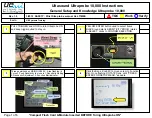
46
slope for those manufacturer’s whose reference electrodes are always moving toward the failure that requires
replacement of the pH/reference sensor.
5
What is the range of millivolts for each pH solution?
You asked that question because you’ve been taught to worry about pH mV by another multiprobe manufacturer,
didn’t you? Because you have become used to worrying about mV’s because that multiprobe requires frequent
replacement of the pH/reference electrode? With a Scuba, just refill your reference electrode every two months or
so and forget about mV’s. You have more important things to do than worry about mV’s.
6
How do I get the barometric pressure reading for the DO calibration? Do I need to check it to a certified
barometer?
You can enter an exact BP from, say, your lab barometer (don’t use the weather station’s BP – it’s corrected to sea
level). Or, you can enter your elevation and the Scuba will estimate your BP. Or, if your Scuba has a depth sensor, the
Scuba can use it to measure BP.
7
Will my Scuba also report TDS and/or Salinity?
Yes; please see Section 4.8.
8
How often should I change the pH electrolyte?
Electrolyte usually lasts two months or more. But if you are logging data, or monitoring in very low conductivity
waters, change your electrolyte each time before you recalibrate pH to be safe. You may learn a better rule of thumb
as you review your data. (4.10)
9
How long with my DO cap last?
You’ve been paying € 175 a year to replace DO caps, haven’t you? It’s OK; lots of people have been in the same boat.
Now that you are a Scuba owner, you can expect your DO caps to last five years or more. You can see the condition
of your cap when you calibrate DO. (4.7)
10
How often should I change my turbidity wipers?
Wipers usually last for years, but you should change yours if it gets stiff or has nicks in it. (4.13)
11
Can I customize the Scuba with different configurations of sensors?
We can fit up to 12 sensors in just about any combination you need. (4.1)
12
Can I replace the sensors myself, or do I have to ship the Scuba back to Eijkelkamp?
You have been led to believe that sensors need “wet-mateable connectors”, haven’t you? So that you can change
failed sensors easily? Eijkelkamp sensors seldom need replacement – that’s why they have a three-year warranty
instead of the one-year warranty offered for lesser sensors. But if you have a problem, Scuba sensors are easy to
replace. Contact Eijkelkamp customer service for assistance.
13
Why can your turbidity read negative?
We let the turbidity reading go negative to indicate a problem with the turbidity low calibration. If, for instance, you
calibrate at zero with water that is actually 5 NTU, then any sample less than 5 NTU will read negative. Recalibration
would be in order. Some manufacturers “clip” their turbidity readings at zero to avoid this question, but that’s
misleading and throwing away perfectly good information. (4.13)
14
How long do ISE tips last?
The usual rule is six weeks, but you may get more or less than that. Change tips often to be safe, but you may learn a
better rule of thumb as you review your data. (4.15)





































